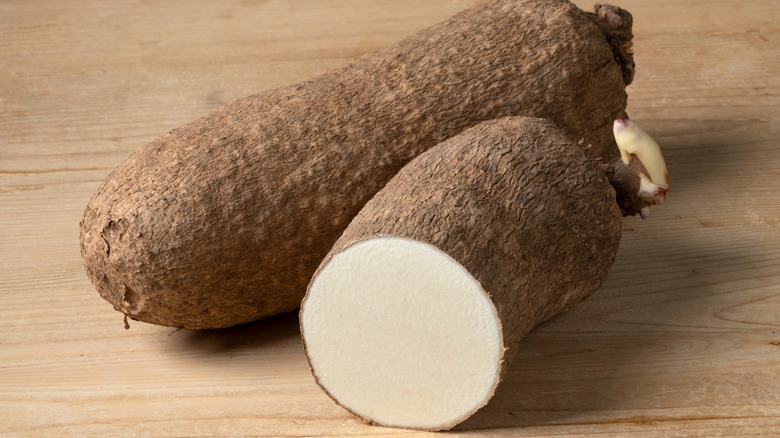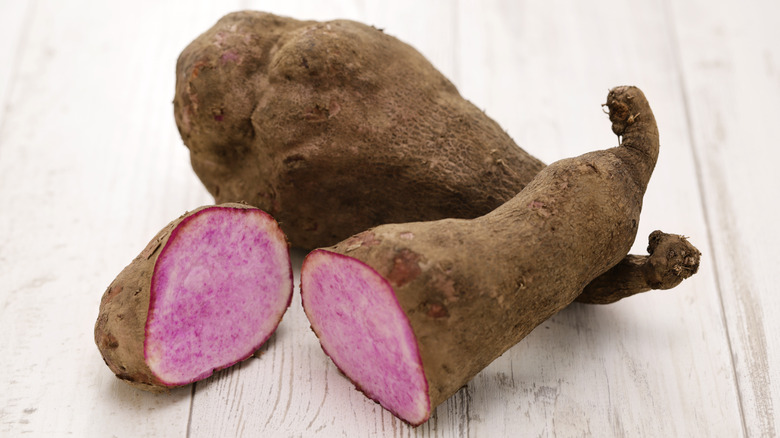Why You Can't Just Substitute Yams With Sweet Potatoes
To many Americans, yams and sweet potatoes are interchangeable and indistinguishable; however, the two tubers are not the same, nor are they even related. The truth is, you've likely never had a true yam before. Those sweet, candied yams you often see on the Thanksgiving table are actually mislabeled sweet potatoes. The confusion dates back to the trans-Atlantic slave trade, but agribusiness marketers deliberately doubled down on it in the 1930s. This historical mix-up has affected more than just product labels, as neither vegetable should be substituted for the other in recipes.
Yams and sweet potatoes are very different from one another. In terms of roots, yams belong to the Dioscoreaceae family and hail from Africa and Asia, whereas sweet potatoes are part of the Convolvulacea family and were domesticated in South and Central America. Except for the purple ube (not to be confused with the purple sweet potato), most types of yams generally have white or light-yellow flesh and rough, brown skin resembling tree bark. Their taste is also distinct from that of sweet potatoes. True to their name, sweet potatoes are usually much sweeter than yams, which are fairly starchy and dry. Given their variations in color and flavor, these root vegetables shouldn't be swapped as ingredients in the kitchen, plain and simple.
Most yams are more like potatoes than sweet potatoes are
Real yams can be difficult to find in the U.S. unless you visit an international or specialty grocery store, so to learn more, we should seek out where they're commonly cooked. Since 95% of yams are grown in Africa (via Library of Congress), the root vegetable is a staple food throughout the continent, especially in Nigeria, which cultivates more yams than any other country.
Common varieties of yams, particularly white and yellow, are often cooked like potatoes or yuca — think boiled, fried, roasted, or baked. For instance, pounded yam, a traditional Nigerian dish, is comparable to mashed potatoes and is often served alongside African soups and stews. It's also used as a thickener, thanks to its starchiness. While you can also cook sweet potatoes using these methods, yams provide a drier texture and are typically less mushy. As such, real sweet potato fries wouldn't have the same satisfying crispiness and savory flavor that salted strips of fried yam do.
Still, with over 600 yam varieties, there's plenty of room for variation in texture and flavor. For example, the Japanese mountain yam, often called yamaimo, is slimy and slippery — much more similar to jícama than yuca. This yam variety can be pan-fried but is fondly enjoyed raw. It's also commonly served grated or thinly sliced in miso soup or on top of soba noodles.
Ube is as close to a sweet potato as a yam can get
The yam that tastes the most similar to the sweet potato is likely ube, a vibrant tuber that's usually (but not always) purple. It's much sweeter and more colorful than most yams, featuring a flesh that ranges from creamy white or lavender to a deep violet. Its dark skin also has that signature bark-like texture. Popular in Filipino cuisine and often paired with coconut or condensed milk, it's a star ingredient in beloved desserts like halo-halo. Ube is also commonly enjoyed (and used in cooking) as ube halaya, which is made by boiling and mashing the yam with sugar, butter, and coconut milk. This pudding-like jam can be eaten on its own or used as a base in desserts like ube cheesecake.
Ube's purple color makes it resemble the Okinawan sweet potato or taro, another root vegetable; however, ube is sweeter and more moist than taro and has a nuttier, creamier flavor than a purple sweet potato. Therefore, while most yams are starchier and dryer than sweet potatoes, the opposite is true in this case. Accordingly, the two aren't ideal substitutes in terms of taste or texture, though this might be the closest swap possible if you're preparing a purple, potato-y dessert. When cooking with other types of yams, however, there's no room for comparison — or substitution — with sweet potatoes.


